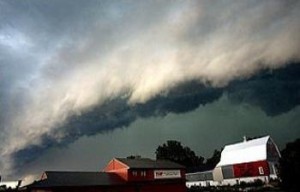Carbon Pollution Creating A 'Cocktail Of Heat And Extreme Weather'
 Two House Democrats have released a report that aims to connect the dots on climate change and extreme weather events.
Two House Democrats have released a report that aims to connect the dots on climate change and extreme weather events.The staff report, issued by Henry Waxman (D-Calif.) and Edward Markey (D-Mass.), outlines the past year’s record-setting temperatures, storms, droughts, water levels and wildfires, and is being circulated in an attempt to rebuild congressional momentum to address climate change.
“The evidence is overwhelming — climate change is occurring and it is occurring now,” said Rep. Waxman, a Ranking Member of the Energy and Commerce Committee, in a statement.
The report outlines the stunning array of record-breaking extreme weather events throughout 2012 within five categories:
Extreme temperatures
•July was the hottest month ever recorded in the continental U.S. Some areas were 8 degrees warmer than average, with the average temperature in the lower 48 states at 77.6 degrees Fahrenheit, 3.3 degrees above the 20th century average.
•Spring 2012 saw the warmest march, third-warmest April and second-warmest May in history, and was approximately 5.2 degrees Fahrenheit above average overall.
•Through late June 2011, daily record highs were outnumbering daily record lows by 9-to-1.
Drought
•As of September, 64 percent of the continental U.S. is experiencing drought, with August and September 2012 comparable to the worst months of the 1930s Dust Bowl.
•By the beginning of August, more than half the counties in the U.S. had been designated disaster zones because of drought.
•As of August, 51 percent of corn and 38 percent of soybeans grown in the U.S. were rated as poor or very poor by the U.S. Department of Agriculture. Some states’ corn fared worse – Indiana had 70 percent of its corn rated as poor or very poor, and Missouri had 84 percent.
Wildfires
•This fire season 8.6 million acres – roughly the size of Connecticut and New Jersey combined – have burned in the U.S., with fires still burning in parts of the West.
•Wildfires in Colorado have killed six people, destroyed 600 homes and caused about $500 million in property damage.
•There has been nearly a four-fold increase in large wildfires in the West in recent decades, with fires burning longer and more intensely and wildfire seasons lasting longer.
Storms
•Tropical Storm Debby caused Florida to have its wettest June on record. The storm killed at least seven people and also damaged more than 7,500 homes and businesses.
•In July, the “derecho” storm system killed at least 23 people and left more than 3.7 million people without power.
•In August, Hurricane Isaac caused storm surges of up to 15 feet in some places and contributed to Louisiana and Mississippi experiencing their second-wettest August on record and to Florida experiencing its wettest summer on record.
Extreme water levels and water temperatures
•In July, water in the Great Lakes reached temperatures of 60 and 65 degrees Fahrenheit – more than 10 degrees warmer than the same time last year.
•In August, water temperatures of up to 97 degrees and low water levels caused tens of thousands of fish to die in Midwestern lakes and rivers.
•Low water levels in the Mississippi watershed have caused some barge companies to reduce their loads by 25 percent and have caused harbor closures in Tennessee, Missouri, Arkansas and Mississippi.
According to the report, 2012 natural disasters (not including wildfires or drought) have caused $22 billion in insured losses and more than 220 deaths as of August. The full cost of 2012’s extreme weather events isn’t yet known, but it’s expected to rival 2011’s record-breaking $55 billion.
The document outlines what scientists following the link between extreme weather and climate change have been saying for years: more carbon pollution adds extra energy in the atmosphere, thus warming the planet and making extreme weather events more likely.
“This is what global warming looks like at the regional or personal level,” said University of Arizona scientist Jonathan Overpeck, speaking to the Associated Press recently. “The extra heat increases the odds of worse heat waves, droughts, storms and wildfire. This is certainly what I and many other climate scientists have been warning about.”
Research shows that Americans are responding to these extreme weather events. According to separate polls from Yale University and the Brookings Institute, a majority of Americans say climate change is happening and that a warming planet makes weather events worse. Pollsters say these responses are directly influenced by personal experience with extreme weather.
In order to help people understand their research, scientists have been using metaphors to draw the connection to extreme weather. A very effective extended metaphor compares carbon pollution to a baseball player on steroids. Thomas Karl, director of NOAA’s National Climatic Data Center explains:
Well, the best way we can describe it, it’s sort of like a baseball player on steroids.
Now, if you’re going to break records, home run records, you’re likely going to have to be a home run hitter to break home run records. With someone on steroids, the likelihood of hitting a ball over the fence and hitting a home run increases. And that is what we’re seeing. The increase of greenhouse gases in the atmosphere leads to warmer global temperatures.
Those then break global temperature records. They also have other impacts, like increases in precipitation intensity, more intense droughts. These are the kinds of things we’re seeing, more records with greater severity and intensity than they would — might have otherwise been.
Even while Americans show an understanding of climate science, the staff report from Waxman and Markey comes at a time when political resistance to climate action is at an all-time high and both political candidates avoid speaking openly on the issue.
You can return to the main Market News page, or press the Back button on your browser.

